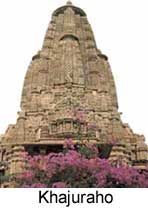 Khajuraho
Khajuraho
Khajuraho was the capital of the Chandella kings, who built temples there from the mid-900's and through the 1000's. The largest temples rise from high bases into a series of peaks culminating in a single, immensely high tower. From far away, they look like mountain ranges. Both Hindu and Jain temples were built in the same style at Khajuraho. The walls and towers are decorated with hundreds of figures, including gods and goddesses, beautiful women, lovers, and mythical beasts.
Bagh
The Buddhist caves at this site are now mostly collapsed and destroyed. They belong to the 5th century Gupta period and are related to contemporary monuments in the Deccan. Of the Bagh group, four caves (2,4,5 and 6) are important. These are similarly laid out. The Bagh caves were once laid out with a splendid series of murals comparable to those preserved at Ajanta. Unfortunately, the paintings at Bagh have mostly disintegrated; the only substantial fragment to have been preserved is in cave 4.
Dashavatara Temple (Deogarh, M.P.)
This ruined Hindu shrine consists of a square sanctuary raised on a moulded basement. The surrounding covered passageways and adjoining mandapa or porch have now vanished. The superbly carved wall panels and shrine doorway are among the masterpieces of Gupta art, particularly the sensuos modeling and the subtle expressions of the figures. Decorated plasters frame panels on all three sides: this depict Lord Vishnu on Garuda rescuing the elephant Gajendra (north), the penance of the sages Nara and Narayana seated beneath a tree (west) and Vishnu sleeping on the serpent Seshnag with the five Pandava warriors and Draupadi beneath (south), the doorway (east) incorporates guardian figures and attendants (beneath), amorous couples (jambs), river Godesses (upper corners) and an image of Lord Vishnu seated on the serpent Seshnag (lintel). Only the lowest corner of the towers that rises over the sanctuary are preserved. The basement of corner subsidiary shrines and several columns are elevated on a broad terrace. The sides of this terrace are ornamented with friezes depicting scenes from the Ramayana and the Krishna legends.
Chaturbhuja Temple (Gwalior)
Constructed in a ravine, this dilapidated Hindu building consists of a small sanctuary with a curved tower, now rebuilt, that adjoins a small porch. Wall niches, columns and doorway preserve little of the original detail. The sanctuary enshrines a later image of Lord Vishnu. The temple is constructed witin a later colonnade.
| 


